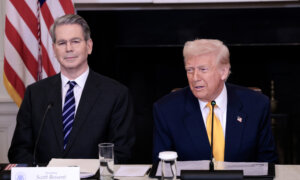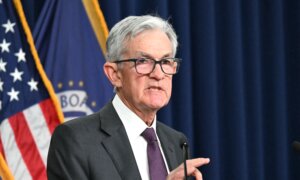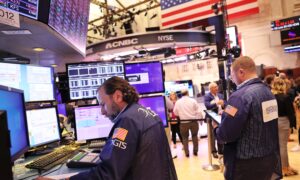Commentary
We are seeing, once again, that the stock market is a manic crowd. A crowd does not think, it merely reacts. On March 10, the stock market ignored the news that Taiwan Semiconductor’s sales surged 43 percent in February and instead focused on a Bloomberg report that Apple (AAPL) was delaying the launch of Siri AI upgrades, as well as its smart home hub. When a huge tech component of Nasdaq, like Apple, contracts, it tends to fuel panic selling, while Taiwan Semiconductor’s explosive sales growth was largely ignored.
Even after the March 14 recovery, we still have a grossly oversold stock market that is threatening to “retest” its recent lows. I suspect that Nvidia’s AI Conference for Developers could help many of the AI stocks to recover, then start soaring again. During the last day of the Nvidia conference, the focus will be on the development of quantum computing, which Nvidia is striving to dominate with selected partners.
Here are the most important market news items and what this news means:
• Retail sales have risen 3.1 percent in the past year and are running a bit higher than inflation. The Commerce Department reported that February retail sales rose 0.2 percent, which was substantially below economists’ consensus expectation of a 0.6 percent increase. Also notable is that January’s retail sales were revised lower to a 1.2 percent decline. Online sales surged 2.4 percent in February and was a bright spot.
• After the retail sales report, the Atlanta Fed revised its first quarter GDP estimate to an annual 2.1 percent decline, up from its previous estimate of a 2.4 percent decline. Since the ISM manufacturing and service PMIs are expanding, any gross domestic product (GDP) drop is largely attributable to the dumping of goods in the United States to beat any tariffs. The irony is these excess goods are expected to be deflationary, so the good news is that, in the wake of the unchanged February Consumer Price Index (CPI) and a -0.1 percent Producer Price Index (PPI) reading, these deflationary forces are expected to persist because of excess inventories from the dumping of goods.
• There is something very calming and yet assertive in Treasury Secretary Bessent’s voice. Bessent has effectively replaced Fed Chairman Jerome Powell as the most important economic spokesman. Bessent on Maria Bartiromo’s show on March 18 said that the underlying economy is healthy and there’s no reason for the United States to see a recession. He said there may be a “pause” as the economy transitions from relying on government spending, but the Trump administration is “going to get this spending under control, we’re going to bring manufacturing back home and we’re going to make the country more affordable for working Americans.”
• The big news this week will be the Federal Open Market Committee (FOMC) statement and an updated “dot plot.” I am expecting the dot plot to signal two more key interest rate cuts this year, but I suspect a minority of FOMC members will also be signaling three key interest rate cuts. However, I am still expecting four key interest rate cuts since I am anticipating global interest rates to crash because of the fact that economic growth in Asia is weak, while Britain, Canada, France, Germany and Mexico are all in the midst of economic contractions. As a result, I am expecting the Bank of England, the European Central Bank, and other central banks to continue to slash key interest rates, which, in turn, will cause Treasury yields to decline and since the Fed does not fight market rates, four Fed key interest rates cut this year are still on the table.
• The Trump trade hysteria has quickly turned into trade talks. The biggest is the United States-Mexico-Canada (USMCA) agreement which is set to expire in 2026. Although Trump 1.0 approved USMCA, under Trump 2.0, President Donald Trump wants to USMCA to be the “fairest, most balanced, and beneficial trade agreement we have ever signed into law.” Interestingly, Trump has praised Mexican President Claudia Sheinbaum, which is a positive development. The other positive development is that Commerce Secretary Howard Lutnick has had some success negotiating with Ontario Premier Doug Ford, who lifted a proposed 25 percent tariff on hydroelectric power.
• Canadian Prime Minister Mark Carney said this week that Canada can only go so far in responding to new import taxes imposed by the United States given the mismatch in size between their respective economies. Carney said, “We’re not trying to organize coordinated retaliation.” This is a positive sign that the tariff debate has moved behind closed doors for Secretary Lutnick and other trade representatives to negotiate.
• Believe it or not, there is some Democratic support for making tariff enforcement even stricter. Ohio Democratic Senator Bernie Moreno has said that the tariff for non-compliance with USMCA should be 10 times higher. Now that several Democrats in the Senate voted for a continuing resolution to keep the federal government open, there may be a brief period of cooperation on tariffs, especially since higher reciprocal tariffs may impact their respective states.
• This is the time of year when global crude oil demand rises as spring weather envelops the northern hemisphere. Another factor is the U.S. missile strikes on the Houthi rebels in Yemen, which are designed to eliminate all Iranian influence in that country. Meanwhile, the ceasefire between Israel and Hamas is over after multiple airstrikes in Gaza ensued. The humiliating hostage releases, with Hamas militants celebrating for propaganda purposes, have just made Israel more resolute in eliminating Hamas. Because of these airstrikes and missile attacks, crude oil prices are meandering higher.
• The call Trump had with Russian President Vladimir Putin may turn out to be monumental. Naturally, Trump wants Putin to agree to a 30-day ceasefire and for the Ukrainian troops surrounded in Kursk to not be killed by Russian forces. Putin wants the United States to acknowledge much of annexed Eastern Ukraine and Crimea as Russian territory. Obviously, both Trump and Putin have a lot to gain by having a successful call.
In summary, the underlying economy of the United States remains healthy. Deflationary forces are expected to persist because of excess inventories from the dumping of goods as importers try to beat the tariffs. Four Fed key interest rate cuts this year are still on the table as global interest rates crash because of the weak economic growth in Asia and economic contractions in Britain, Canada, France, Germany, and Mexico. As Secretary Bessent said, there’s no reason to see a recession for the United States.
*Views expressed in this article are opinions of the author and do not necessarily reflect the views of The Epoch Times.













